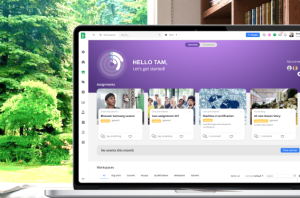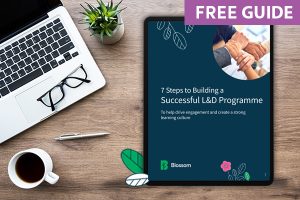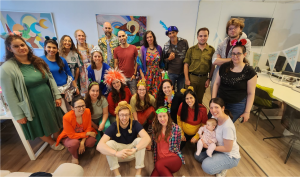Discover how to leverage the democratization of learning to cultivate a strong learning culture and enhance performance. Gain insights into its definition and potential outcomes before implementing it in your organization.
Before we dive into how you should be employing the democratization of learning within your organization, let’s first discuss what it means and what are the outcomes.
What is the democratization of Learning and how can it benefit your organization?
Essentially, the democratization of learning is about empowering all employees within the organization to share knowledge, giving them the freedom to learn from their peers and continually improve. In principle, it will include whatever you want it to include. Let your users define and decide for themselves what and how they want to learn and improve. Prepare and allow them access to the widest set of tools you can, so they can use what best suits and “flows” with them.
If you are able to master this powerful learning approach, it can greatly improve performance within your organization from greater knowledge sharing and engagement, which will in turn lead to improved workforce productivity and customer satisfaction levels. For example, if product managers are learning from customer facing support staff, they will be able to make better informed decisions to drive product development helping to deliver a better product offering which customers will love.
How does this differ from an LXP?
One should not confuse the democratization of learning with an LXP. I’m not a big fan of abbreviations, acronyms and buzzwords, however, an LXP is a Learning eXperience Platform, where the intention is to enable learning at the initiative of the user, who will search for themself, receive recommendations and choose what they want to learn. This independent learning usually comes in addition to the organizational learning assignments that they are obliged to complete due to internal or external regulatory needs. A good LXP system can also contain abrasive tools, personal channels, peer sharing and recommendations, linking to external content providers and so on and so forth.
Throughout my years in the world of learning and training I create new things and break old paradigms. I call the whole LXP world – the democratization of learning – the transfer of responsibility for personal development to the user. The user does not have to, but wants to learn. They want to learn, they want to develop, they want to know, in order to achieve promotion on a personal level. This ideology should be shared and ingrained into the culture of your organization, rather than just promoted via a single tool or a platform.
How to employ the democratization of Learning within your organization
So, what is the first and most important thing that is needed in order to enable the democratization of learning in the organization?
One guess? No, it’s not about technology, nor is it about content or courses either. Well, the first thing that is needed is actually “time” and with the same weight, inquiries are also required.
The learners must have a work environment that encourages learning, which means allowing for some free and quiet time, without business or family background noise. Of course, a budget is also required for the matter. From this we understand that the whole matter requires top-level managerial understanding, buy-in and commitment. The understanding is based on the fact that they may achieve a significant contribution to the team member, who in turn will contribute more to the organization. The understanding is also based on the connection to Work-Life Balance, but we will talk about this principle another time.
The administrative avenue of the organization should understand and accept the principle that the employees should advance and develop professionally, emotionally, and managerially. Managers must understand that when the employees develop and promote themselves, the organization will gain a team with greater capabilities and much more depth.
6 key components for your democratization of learning toolbox
Beyond understanding and managerial focus previously discussed, I will list here the toolbox that should be available to the employee to help stimulate the democratization of learning within your organization. It may seem to you like a collection of independent tools, but in practice it works like an orchestra, where all the tools are intertwined, connected to each other, and synchronized. The winner chooses which tool to use, when and how. Of course, it is desirable to have as many options as possible, but we understand and know that there is a limit to everything.
1. Access to content and courses:
Access to intra and extra-organizational content and courses that may be of interest to your employees should be allowed. You can prepare content and courses within the organization or use the services of external providers who will prepare them for you. You can also connect to free or paid external databases.
There are many databases on the market today: Open Sesame, Linkedin, Udemy, Coursera, EdX and more. These databases may be of interest to your users, and there is a good chance that they will be happy to consume information and courses from them. Beyond the offer of content and courses, what is important in the process of selecting the databases is that there should be simplicity of use: if it is not simple it simply will not be. It is necessary that full integration be possible between the databases you connect, and the organizational learning tools that your employees already use. That way they can search the full database to choose content and courses, without the need to move between different systems and log-in to each system separately.
2. Smart recommendation mechanism:
There is a huge ocean of content and courses in the various databases, so your employees can easily get carried away and drown. Therefore, it is imperative that the toolbox you make available to them includes a smart recommendation mechanism based on machine learning (ML) that will recommend to users’ content, courses and learning objects that are suitable for them directly related to their skills, or more precisely based on their skill gaps in areas in which they have expressed interest.
The smart recommendation mechanism should also take into account the form, type and length of time that is suitable for users to learn, allowing the addition of many more parameters that will help improve it. But basically, the smart mechanism needs to manage the following dimensions:
- Matching skills to occupation.
- Matching skills to courses.
- Defining which level is required for which occupation.
- Defining what skill level the user will receive from the performance of a learning object.
- Defining the objective level of the skills with which the employee came to the organization or that the employee acquired over the years.
Defining who can rate the employee’s skill level: the employee himself, the employee’s manager / team leader, a test the employee passed, an external evaluation, and more.
3. Creating personal playlists:
Allowing users to create a playlist of content that they can watch and consume, to enrich their personal knowledge and skills, or to be more prepared for their next role. Slightly, more advanced organizations can allow users to self-subscribe to their peers’ channels or playlists, and also upgrade their skills as a result of viewing and consuming content created by them.
4. Independent content creation:
Rather than limiting content to that produced by the training administrators or external repositories only, we should create an infrastructure that will allow users to create content themselves, and make it accessible to their colleagues. Such content can be professional articles, action or process videos, self-recordings, or any type of content that may also interest other users in the organization. The user can upload what he has created to his playlists or share the content with other users in the system.
5. Ranking contents and learning objects:
The democratization of training is based on the wisdom of crowds, which can cause the information flood effect to become a literal flood. In order to sort out the wheat from the chaff, and filter content that is less suitable, we should allow users to rate the content and comment on it, so that the other users will understand how appropriate the learning object is for them, how high quality it is, and how it will advance them in the direction they want to go. Depending on the opinion of their peers, they will make a decision whether or not to consume certain content items.
6. Human recommendations on content and learning objects:
The above-mentioned smart recommendation system is not sufficient alone. No matter how good and advanced it is, it still does not drink coffee or conduct small talk with the user, so it may only be able to recommend content and courses, based on a variety of scholarly parameters. Therefore, an interpersonal layer should occur, so that colleagues in the organization will enlighten and recommend to each other a content item or course that may interest them.
Beyond the assimilation and use of technological means, there are also non-technological processes, for the purpose of promoting the democratization of training in the organization:
- Encourage users to make intra-organizational meetups.
- Allow users to initiate professional training and mentorship projects.
- To establish a permanent mechanism of resettlement, investigation and monitoring of lessons learned in the organization, in which ordinary users (not necessarily managers) will take part.
- To encourage an organizational culture, in which emphasis will be placed on sharing and creating information, and rewarding employees accordingly.
- To incorporate attrition mechanisms, whose goal is the constant creation and maintenance of a creative learning atmosphere, and the provision of positive reinforcements to employees for this.
- Any other means and method that you think can transfer the weight of creation, consumption and learning to the users.
Really the sky’s the limit here. Perhaps you will consult with your employees in the organization on the subject, and you will be surprised what amazing proposals they will come up with.
Remember, that in modern and advanced organizations, it is not important to refer to learning at the level of the individual employee, but also at the level of the entire organization. In order to be able to make the transition from a “learning employee” to a “learning organization”, innovative technologies and methods must be trained, but the most important thing is to change the thought pattern. Most knowledge is found among the masses, and in order to get hold of this vast knowledge and to harness the knowledge for the benefit of the organization, it must allow employees an appropriate ecosystem in which they will learn, promote themselves, create knowledge and share it with joy.
So, what are you waiting for??? Start preparing your organization for the democratization of learning.
Author:
Eldad Nir, CEO of Blossom
Entrepreneur, entrepreneurship evangelist, CEO, and business developer in multiple disciplines.
As a 22-year-old, Eldad founded my first business and sold it five years later. Since then, he has established, excited, and participated in many ventures. Eldad first invested in Blossom KC in 2010 and since then he has led it to great success also thanks to the amazing team he works with.
He is a proud father of 3 amazing boys, and is a fitness enthusiast and thrill-seeker. Not only does Eldad run, surf-ski, and swim almost every day, he loves mountain climbing, and has accomplished more than 1500 skydives around the world.
Blossom’s blog contains more tips and information from the digital world for complete organisational management.








